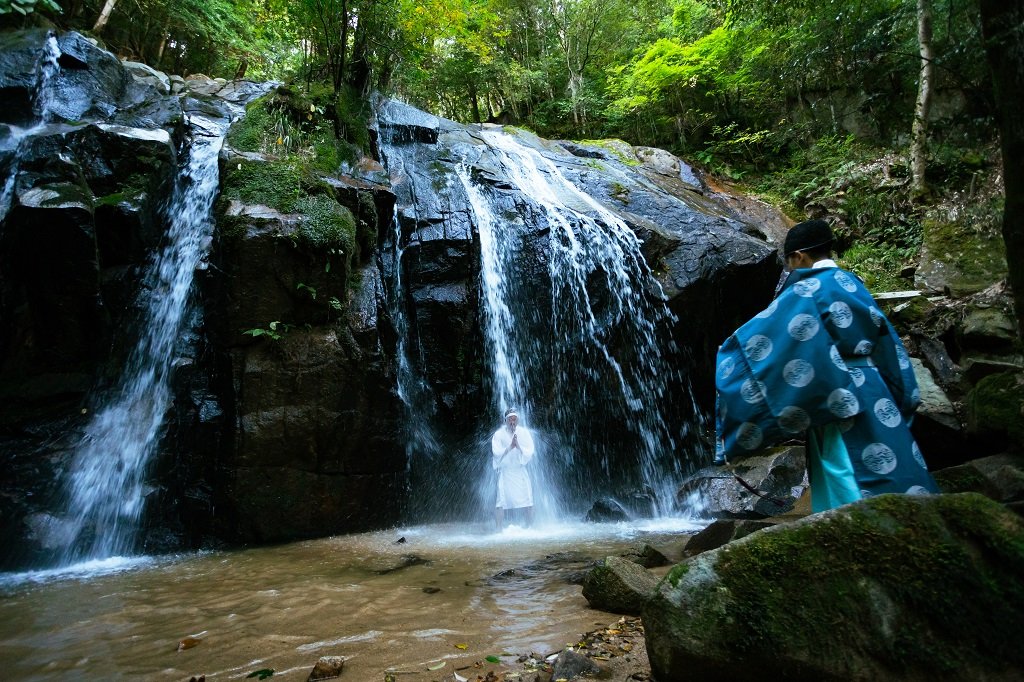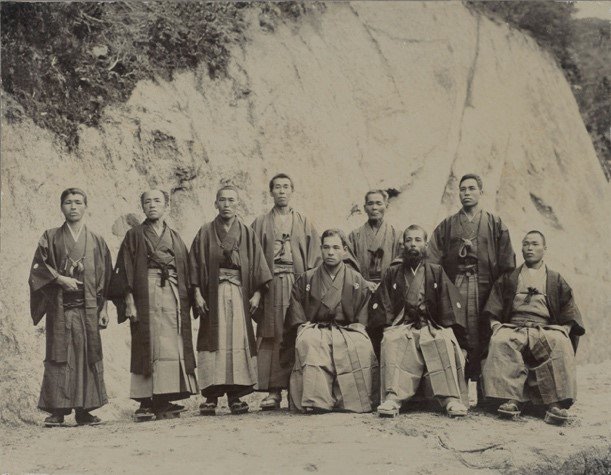Takigyo: waterfall rituals
town and culture 12.1.2022
Kanabiki Falls
Kanabiki Falls is the only waterfall in Kyoto Prefecture selected as one of the “100 Best Waterfalls in Japan.” Kanabiki has been a sacred mountain for over 1000 years and is famously mentioned in a historical ballad tied to the region.
January 1, 1911 Postcard sent as a New Year's greeting. It shows the shrine at that time. The date of construction is unknown, but it appears to have been a thatched-roof structure.
In the past, this waterfall was also called "Arita Falls" because it was located in the village of Arita. The word "Kanabiki" comes from Kanabiki Mountain, which is also commonly known as Mt. Daimokuyama. The mountain has long had a spiritual energy, perhaps one of the reasons people have been drawn here for centuries.
The waterfall used to belong to the temple domain of Nyoganji, and some say that it was founded by Kokei Shonin around 1049, which would be about 1,000 years ago, around the time of Emperor Goichijo. It was next modified by the Honso clan during the old feudal era. The head of the clan personally led his vassals to the shrine every day to train their minds and bodies, and also set up a place to rest. For meals they had soba made with a waterwheel. This is the origin of "taki soba" (waterfall soba).
|The many falls of Kanabiki
Garyu Falls (reclining dragon falls): According to the legend of the White Dragon, the shortest flowing waterfall is called Garyu Falls because of its resemblance to a sleeping dragon.
Hakuryu-Falls (white dragon falls): The middle waterfall is named after the dragon god who, according to the Hakuryu legend, lives here.
Otoko Falls (male falls) and Onna Falls (female falls): Otoko Falls has four points where the waters cascade, and the Onna Falls has three; together they are called Shichijo Falls, meaning seven falls.
The reason the waterfall basin is so shallow
Kisshoin, one of the temple’s buildings 0riginally located at Nyoganji Temple, was moved to Kinbiki Falls at some point in the past. As this temple deteriorated, the nun who became its last abbess threw herself into the White Dragon Falls below. At that time the waterfall was believed to be bottomless, deep blue-black in color and always swirling. But after the war, stones were broken off the cliff and used to fill in the waterfall basin to prevent water from overflowing the path leading up to it. And since then, the waterfall basin has been much shallower. In fact, it is thought that the construction of a forest road around 1940 caused a large amount of rocks broken above the waterfall to fall into the waterfall, and that several heavy rains and landslides buried the deep waterfall basin.
The legend of the white dragon
A mother dragon is also said to have protected Acala (a buddhist diety enshrined here) who had also turned into a dragon. The mother dragon lived on a large boulder leading to a cave, and her offspring would descend the river below to live at Shinto shrines. The river connecting to Kanabiki Falls is a path connecting children and parents.
|Kanabiki from esoteric to popular
In this photo, representatives of the village gathered to build a road in the vicinity of the waterfall for the purpose of publicizing Kanabiki Falls for visitors, and a commemorative photo was taken when the road was completed (around 1913).
In the 4th year of the Meiji period (1871), a marine product expo was held in Miyazu, and a new road was developed with the support of the nearby village to improve the waterfall. It was at this time that a large resting place was built under the waterfall, and even the governor of Kyoto Prefecture visited the park. This development in the Meiji era was the beginning of Kanabiki tourism.
|But previously there had been many ill-fated attempts to make the waterfall accessible to visitors.
There seems to have been a movement to create a park from around 1897, and an article in the "Nichide Shinbun" (daily newspaper) states that the mayor of Joto Village, Sahei Kusuda, and two or three others were initiating the project.
There was also a group of volunteers trying to increase access, but on August 25, 1907, Miyazu was hit by a major flood, and much of the area was buried under sand. Cliffs and mountains collapsed and the enormous amount of water and sand turned even the surrounding region into a sea of mud.
In 1917, repair work resumed. A rest area was reconstructed under the main hall at Kanabiki Falls, and a shop was set up under the rocks to sell soba, udon, and other dishes. At this time, the shrine was rebuilt, which was the foundation for its present form.
But then in 1927, the Kita-Tango Earthquake hit the area, destroying the rest area, leaving only the shop.
It wasn’t until 1963 that the Kanabiki Acala Foundation was set up to raise money for the shrine and precints. They successfully raised 444,500 yen to aid in clearing the area, restoring buildings, a shop, as well as restrooms to help revive the temple. Further, in 1978, the road was repaired, and in 1980, the entire road was paved, making it possible for people to drive closer to the Kanabiki Falls.
Lastly, in 1990, thanks to the efforts of volunteers, Kanabiki Falls was selected as one of the "100 Best Waterfalls in Japan" and it continues to have this distinction today.
try waterfall rituals at Kanabiki Falls
Waterfall rituals, called takigyo, is an act of purifying the body and unifying the spirit. It is known as a severe spiritual practice, in which one immerses oneself in the intense water of a waterfall in the cold of winter. It is a method of confronting yourself to replenish your spirit, both mentally and physically. People who undergo this ritual come out of it refreshed with a strong sense of accomplishment.
For a slightly more relaxed version, a pop-up-sauna can be arranged at the site of the waterfall rituals for a spa-like experience to accompany your trials!
*Inclement weather does have the chance to cause sudden cancellations.
Incidentally, this waterfall has long been famous for the phenomenon of hearing human voices. At times, you might five or six people talking, and at other times visitors hear something like a sutra chanting. The voices are often heard when the water flow volume is high, so if you come, listen carefully!
Want to try takigyo!? For booking inquiries, please contact Kyoto by the Sea DMO!









